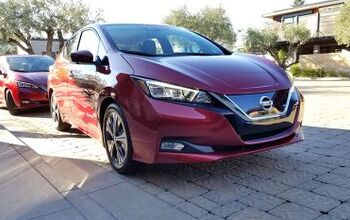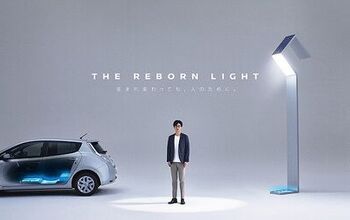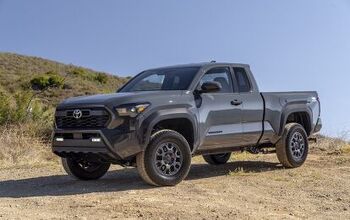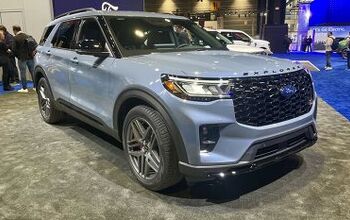2018 Nissan Leaf Review

The original Nissan Leaf helped bring electric vehicles to the mainstream, but one aspect of the recent redesign has some EV enthusiasts puzzled: just 150 miles of range?
That number seems low in the wake of the Chevrolet Bolt, which has over 230 miles on tap, and upcoming EVs from Hyundai, Jaguar, and Tesla are also boasting a rating over 200 miles, so it makes sense for EV fans to be concerned about the Leaf’s lack of competitive range.
However the new Leaf’s range is is a significant bump from what it used to have, and there’s certainly more to the story than just the range, which, by the way, far exceeds what the average American commute entails.
It’s almost a 50 percent increase in range, achieved with just a 10 kWh bigger battery, which is stuffed into just about the same amount of space as the last Leaf. That’s achieved by clever engineering, and it bodes well for the future of Nissan’s electrified vehicles. The 40 kWh battery is laid out a bit differently than the old 30 kWh one, and there is also a new and improved processor at the helm of this power source, which will also help improve efficiency.
FAST FACTS
| Engine: | Single electric motor |
| Output: | 147 hp, 236 lb-ft of torque |
| Transmission: | Single speed direct drive |
| Weight: | 3,433 lbs (1557 kg) |
| Battery Range: | 150 miles (241 km) |
| US Price: | $30,875 |
| CAN Price: | $37,998 |
| : | (Pricing includes destination) |
That’s important because the Leaf has an extra trick to help improve its range while in motion, primarily in the form of the e-pedal feature. This allows the accelerator to act as both the throttle and braking pedal and helps aggressively recapture energy back to the battery. This works by combining both regenerative braking and friction braking to provide up to 0.2 Gs of braking force. It can bring the car from highway speeds to a stop in just about 20 seconds, a wild concept when you realize you’re just lifting your foot off the pedal. It takes a lot of time to get used to, especially to the idea that there’s almost no form of coasting while the e-pedal feature is active. The additional advantage is that the regenerative braking system is so good that a Leaf can go a very long time without needing any maintenance or service to its brake pads.
You can turn off the e-pedal if you wish, which provides a more natural driving feel, and there are other drive modes that alter the way the car reacts to inputs and coasting. A much-appreciated feature is that all your drive mode settings will stay after you restart the car. No need to set everything up back to the way you prefer every time you turn on the car. Smart thinking by Nissan since these settings can drastically change the way you drive the car.
The battery takes 7.5 hours to charge using a level 2 charger and can get a quick charge to 88 miles in just 30 minutes. An interesting wrinkle for Canadian spec Leaf buyers is that they’ll get a portable charger that supports both L1 and L2 systems. This means the same cable can be used for 120V and 240V outlets, so if you have the type of plug a household dryer uses, the Leaf can plug right into that and get Level 2 charge rates. The automaker has also revised the plug position for better ergonomics, making it more upright so you won’t have to squat and bend over to plug the charger in.
Mated to the new battery is an electric motor that makes 147 horsepower and 236 lb-ft of torque. If you’ve never been in an EV, the smoothness and immediate response of an electrified powertrain is really impressive and will certainly surprise you. Its quick and gets to highway speeds convincingly enough. It’s so linear in its power delivery and putting your foot down is very satisfying. It’s a shame that it’s only so much fun for the 150 miles or so.
Impresses Beyond the Electric Powertrain
But as mentioned before, there’s much more to this car than just that conversation about its range.
Primarily, the talk should be about its price. At $30,875 before incentives ($37,998 in Canada) the Leaf is by far and away cheaper than the Bolt, even if it doesn’t have the same range of that EV with its 60 kWh battery. The Leaf is cheaper than the VW Golf and Kia Soul EV and has more range than those two and the Hyundai Ioniq EV.
Simply put the Leaf sits in a very happy niche where it’s less expensive than the Chevrolet Bolt and has less range than the Chevy, but is also less expensive and has more range than many of the alternatives.
Interior
It also packs a well-built cabin that has a good mix of higher grade materials alongside harder stuff. There’s a nice looking digital dash which provides a number of informative displays, and the infotainment system, while looking a bit aged, has support for Android Auto and Apple Car Play. The car also has a telematics system that allows for remote charging, pre-conditioning the cabin temperature, locking and unlocking the vehicle and other things like a teen-driver geo-fencing alert system for parents.
There were more than a few times I wish the driving position could be better. I often felt like I was sitting too high and upright, and the seat wouldn’t lower any further. The rear seats provide just enough space, and it packs 23-cubic feet of trunk space on tap.
ProPilot Assist
The Leaf also comes with ProPilot assist, a hands-on suite of driving aids, which helps to make driving in certain conditions less stressful. It’s essentially an advanced version of adaptive cruise control and lane keeping assistance to help out on the road.
However, the conditions you might expect to get an assist are the ones that ProPilot Assist won’t help in. During rainy weather with inclement visibility, the system won’t remain active while the windshield wipers are active. Naturally, this is done in the interest of safety, so you won’t be relying on a system that isn’t working at its best. Instead, the car will aim to make easier to drive on a congested or empty highway setting. It works as advertised, keeping the car in its lane and bringing the car to a complete stop in traffic.
There are other handy safety features here too, like a driver fatigue monitor, automatic emergency braking, 360-degree camera, rear cross traffic alert and high-beam assistance. The Leaf is loaded with helpful tech.
The Verdict: 2018 Nissan Leaf Review
The Leaf looks like it’d be a great second car in a household. It’s compact and green, with a nice low price tag that’s further impressive with all the available government incentives out there. It also recently won the World Green Car of the Year award, so its upgrades are not just for show. It might not have the range to be a household’s only car, but it is attainable enough to be a nice alternative for many buyers out there.
LOVE IT
- Looks good
- Great price
- Unique e-pedal
LEAVE IT
- Wished for more range
- Awkward driving position

Sami has an unquenchable thirst for car knowledge and has been at AutoGuide for the past six years. He has a degree in journalism and media studies from the University of Guelph-Humber in Toronto and has won multiple journalism awards from the Automotive Journalist Association of Canada. Sami is also on the jury for the World Car Awards.
More by Sami Haj-Assaad






















































Comments
Join the conversation